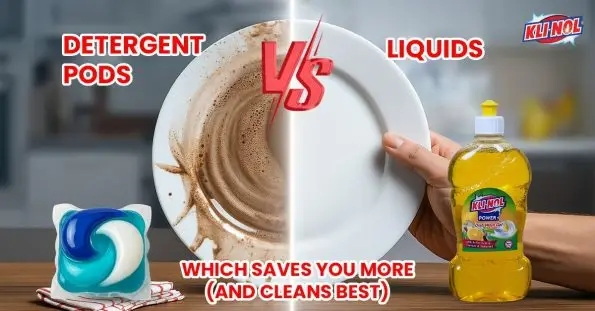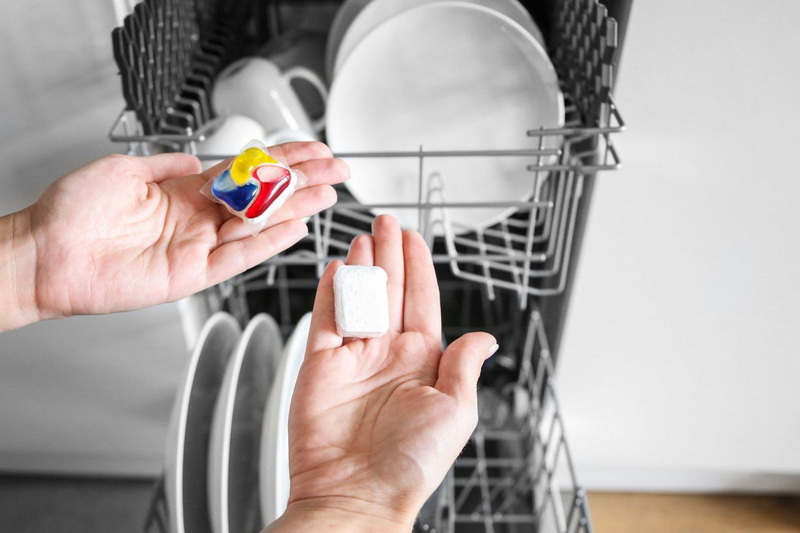Dongguan UFine Daily Chemical Co.,Ltd.
- All
- Product Name
- Product Keyword
- Product Model
- Product Summary
- Product Description
- Multi Field Search
Views: 222 Author: Tomorrow Publish Time: 11-10-2025 Origin: Site











Content Menu
● What Are Dishwasher Pods and Liquids?
>> Liquid dishwasher detergents
● Cleaning Power and Effectiveness
>> Ease of use
● Safety and Practical Considerations
>> Safety
● Compatibility with Appliances and Detergent Types
>> HE vs. standard dishwashers
>> All-in-one vs. separate products
● Real-World Scenarios and Recommendations
>> Family with mixed dish loads
>> Small kitchen with limited storage
>> Professional kitchen settings
>> Environmental and budget priorities
● Technology and future trends
● Safety reminders and best practices
● FAQ
>> 1. Do dishwasher pods work in high-efficiency (HE) machines?
>> 2. Can I use liquid detergent in place of a pod for tough stains?
>> 3. Are pods safer for households with children or pets than liquids?
>> 4. Which option is more environmentally friendly?
>> 5. Will using pods or liquids affect residue on glassware?
Dishwashing efficiency, convenience, and cost are important considerations for households and commercial kitchens alike. With the rise of concentrated, pre-measured dishwasher pods and traditional liquid detergents, consumers often ask which format offers the best balance of cleaning power, ease of use, and value. This article examines the differences between dishwasher pods and liquid detergents, focusing on performance, dosage accuracy, environmental impact, safety, and practical usage. By weighing these factors, readers can determine which option aligns with their priorities and dishwasher setup.

- Pods are pre-measured detergent capsules encased in a dissolvable film. They typically contain a combination of cleaning agents, enzymes, rinse aid, and sometimes smart additives designed to improve soil removal and resistance to hard water.
- Most pods are designed for standard cycles and are compatible with high-efficiency (HE) and traditional dishwashers.
- Some pods incorporate color-changing indicators to show when the detergent has dissolved, offering a quick visual cue for users.
- Liquids come in bottles and require manual dosing. They may include concentrated formulations and can be combined with rinse aids or other dishwasher aids.
- Some liquids are “all-in-one” formulations that include rinse aid and sometimes pre-soaking agents, while others are dedicated detergents requiring separate rinse aid.
- Liquid formulations may offer more flexibility for unusual loads, such as very large items or irregular dishware, because you can adjust the amount more precisely.
- Enzymatic action: Pods often include enzymes that break down starches and proteins more effectively, contributing to stubborn stains and baked-on residues. The enzymes tend to perform best in water temperatures within the machine's normal operating range.
- Surfactants: Both formats use surfactants to reduce surface tension and lift grease; the exact formulation varies by brand and product line. Some advanced pods include patent-pending surfactants that target difficult soils.
- Water hardness: In hard water areas, certain pods include built-in anti-spot or water-softening components, which can reduce spots and film. Liquids may require an additional rinse aid to achieve similar results. In some cases, hard water can reduce cleaning efficiency if the detergent lacks sufficient chelating agents.
- Temperature stability: Pods are generally formulated to release ingredients when exposed to specific melt points inside the dishwasher. If a cycle operates at lower temperatures, some pods may require longer wash times to achieve optimal dissolution and cleaning power.
- Residue prevention: Both formats can leave residue if not used correctly. Pods reduce the risk of under- or over-dosing, but improper storage or damaged packaging can compromise performance. Liquids can leave streaks if too much is used or if the rinse aid is insufficient.
- For typical daily dish loads, pods tend to deliver reliable results with less user error. Liquids can be equally effective when dosed correctly, but misdosing can lead to residue or inadequate cleaning.
- Heavily soiled pots and pans may benefit from a pre-soak or a more robust detergent formulation, whether in pod or liquid form. In some cases, liquids designed for heavy-duty cleaning may outperform standard pods on tough residue.
- For glassware, rinse aids play a critical role. Pods with built-in rinse aids can reduce spotting, whereas liquids paired with a high-quality rinse aid can achieve similar clarity.
- Pods: The pre-measured format eliminates guesswork. One pod equals one dishwasher load, simplifying routines and reducing the chance of using too little or too much detergent.
- Liquids: Dosing requires attention. Overdosing wastes product and can cause residue; underdosing may leave films or greasy dishes. A common practice is to adjust dose based on soil level and load size, which demands more user awareness.
- Pods: Highly convenient, especially for households with children or careless cooks. No measuring, less chance of spills. Most people appreciate the neat packaging and low maintenance.
- Liquids: Messier to handle; pour spillage can occur, and cap measurements may be misread or misused. Some households pre-mix a larger amount of detergent to reduce frequent handling, but this can lead to overexposure and waste.
- Pods: Require dry storage to prevent film from dissolving or clumping. They are generally leak-proof but can be vulnerable to moisture in humid environments.
- Liquids: Need a closed container away from heat and direct sunlight to preserve potency. Spills can create sticky cleanup requirements. Some users store liquids in a dedicated kitchen cabinet away from children and pets.
- Pods: Contain strong surfactants and cleaning agents. If ingested by children or pets, they can pose serious health risks, making storage compliance critical. The film can be a choking hazard if punctured.
- Liquids: Also hazardous if misused, but conventional bottles are typically designed to minimize accidental ingestion hazards (cap locks, child-resistant designs in some markets). Spill management is easier with liquids yet still requires caution.
- Packaging: Pods often use compact packaging and may reduce plastic waste per load, depending on formulation and packaging choices. However, the film in pods must be considered for recyclability. Some pods use recyclable or compostable film options, while others rely on standard plastic structures.
- Liquids: Plastic bottles can contribute to plastic waste; recycling availability varies by region. Some brands offer concentrated liquids that reduce overall plastic usage. Refill programs can further decrease waste for liquid detergents.
- Pods: Tend to have higher per-load costs due to the convenience and formulation complexity, but you may save on wastage due to precise dosing. The upfront price per load is often higher, but long-term usage can be comparable if waste is minimized.
- Liquids: Per-load cost can be lower or higher depending on concentration and brand. Savings may come from bulk purchasing or using compatible bottle sizes. Highly concentrated liquids can deliver lower cost per wash but require careful dosing to avoid waste.

- Pods: Generally formulated to work well with HE and non-HE machines. Always check the product label for compatibility notes. Some specialty pods are designed for specific water conditions, such as ultra-hard water or very soft water, which can influence performance.
- Liquids: Some liquids are specifically designed for HE machines, while others are optimized for traditional dishwashers. Using the wrong type can affect performance. All-in-one liquids may reduce the need for separate rinse aids, but you must confirm compatibility with your dishwasher model.
- Pods often function as all-in-one solutions, combining detergent, rinse aid, and sometimes water-softening agents.
- Liquids can be pure detergents or part of a multi-step system that requires a separate rinse aid. Some households prefer all-in-one liquids to reduce the number of products stored, while others favor separate components for greater control.
- Pods offer consistency and ease, reducing the risk of under- or over-dosing, which is beneficial for households with varying levels of dish cleanliness. A single pod per cycle keeps routine simple.
- The choice depends on workflow, budget, and environmental goals. Liquids or pods designed for heavy-duty cleaning with appropriate rinse aids may perform best under high-demand conditions. In large facilities, a cost-per-load analysis and supplier reliability often drive decisions more than consumer-level convenience.
- If minimizing plastic waste is a priority and you have access to recycling programs, pods can be advantageous. They also reduce the risk of overdosing, which minimizes chemical runoff into the wastewater system.
- If you aim to minimize per-load cost and are comfortable with precise dosing, high-concentration liquids may be more economical. In some regions, bulk liquid concentrates minimize packaging waste while delivering strong cleaning power.
- Smart dosing: Some modern detergents integrate smart dosing features in pods or advanced liquids, adjusting release based on water hardness, soil load, or cycle length. This can optimize cleaning performance and reduce waste.
- Biodegradability and enzymes: There is ongoing development in greener enzymes and surfactants that maintain cleaning power while reducing environmental impact. Consumers may start to see more certifications and clearer environmental labeling.
- Compatibility testing: Manufacturers increasingly publish compatibility charts with popular dishwasher models, assisting consumers in selecting products that deliver the best results for their specific appliances.
- Store pods and liquids out of reach of children and pets.
- Keep containers tightly closed; avoid moisture exposure for pods to prevent premature dissolution.
- Follow the dishwasher manufacturer's guidance on compatible detergents and dosing instructions.
- Run a maintenance cycle if you notice residue or film on glassware, location-specific water hardness issues, or detergent buildup.
Both dishwasher pods and liquid detergents have distinct advantages and trade-offs. Pods excel in dosing consistency, convenience, and often providing an all-in-one solution with built-in rinse aids. Liquids offer potential cost savings, flexibility in dosing, and strong performance when used correctly, particularly for heavy soils or specific dishwasher models. The best choice depends on your dishwasher type, water hardness, typical load, storage conditions, safety considerations, and environmental goals. Consumers should try a tested formulation aligned with their machine's requirements and monitor results over several cycles to determine the most effective option for their needs. Regular reviews of water quality, soil types, and usage patterns will help refine the decision over time, ensuring consistently clean dishes while optimizing resource use.

Yes, most dishwasher pods are formulated to be compatible with HE machines, but always check the product label for confirmation.
Yes, but you may need to adjust the amount used and may want a detergent designed for heavy-duty cleaning or add a separate rinse aid.
Pods pose ingestion risks if chewed or opened; keep them out of reach. Liquids also pose risks, but child-resistant caps on many bottles help mitigate accidental exposure.
Pod packaging can reduce plastic waste per load, but the film and packaging materials vary by brand. Liquids can be more recyclable depending on bottle material and local facilities.
Residue can occur with either format if dosing is incorrect, water hardness is high, or rinse aid is insufficient. Using the appropriate rinse aid and following manufacturer recommendations minimizes spotting and film.